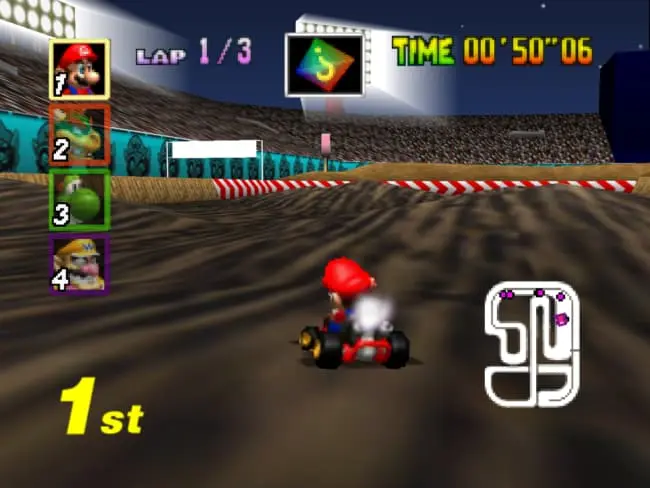Mario Kart 64
- Genre: Racing
- Players: 1-4
- Developer: Nintendo EAD
- Publisher: Nintendo
Description
When Nintendo released Mario Kart 64 in 1996 as the second installment in the Mario Kart series, they didn't just create a racing game—they crafted a social phenomenon that would define gaming nights for years to come.
Four-Player Split-Screen Magic
There was something revolutionary about the four-player split-screen multiplayer that Mario Kart 64 introduced. The television would divide into quarters, each showing a different player's perspective as they raced around vibrant, chaotic tracks. The technical achievement might have come at the cost of resolution, but the multiplication of fun more than compensated.
Weekend tournaments became ritual in basements and living rooms worldwide:
- Players shouting over each other as green shells ricocheted
- The dreaded blue shell's arrival announced by its ominous sound
- Accusations of screen-watching from the player in first place
- The collective groan when someone chose Rainbow Road... again
The Infamous Rubber-Banding AI
The game's notorious rubber-banding AI kept races competitive even when players thought victory was assured. This "catch-up" mechanic ensured that:
- CPU racers mysteriously accelerated when far behind
- First place was never truly safe until crossing the finish line
- Last place always had a fighting chance with the right power-ups
- Every race maintained tension until the final moments
While sometimes frustrating, this mechanic ensured that races remained exciting regardless of skill disparities among players.
The Cups and Tracks
Mario Kart 64 featured four cups with four tracks each:
Mushroom Cup
- Luigi Raceway
- Moo Moo Farm
- Koopa Troopa Beach
- Kalimari Desert
Flower Cup
- Toad's Turnpike
- Frappe Snowland
- Choco Mountain
- Mario Raceway
Star Cup
- Wario Stadium
- Sherbet Land
- Royal Raceway
- Bowser's Castle
Special Cup
- DK's Jungle Parkway
- Yoshi Valley
- Banshee Boardwalk
- Rainbow Road
Each track had its unique personality and challenges. Rainbow Road, with its dizzying neon paths and lack of guardrails, was particularly infamous for its length (taking nearly eight minutes to complete) and difficulty.
Battle Mode: Warfare on Wheels
Battle Mode offered a completely different experience where racing took a backseat to all-out warfare:
- Players hunted each other in specially designed arenas
- The objective: pop your opponents' three balloons while protecting your own
- Arenas like Block Fort, Double Deck, Big Donut and Skyscraper became legendary
- Strategic item use and spatial awareness became more important than driving skill
This mode often lasted longer than races and created some of the game's most intense moments.
The Wario Stadium Lightning Strike
Of all the devious tactics in the game, perhaps none was more satisfying—or devastating—than the Wario Stadium shortcut. If timed perfectly, a player could:
- Save a Lightning item for the precise moment an opponent took the big jump
- Use it just as they became airborne
- Watch as they shrank mid-air, causing them to fall below the track
- Turn a promising race into total devastation in seconds
This maneuver would invariably be accompanied by howls of disbelief from the victim and cheers from everyone else in the room.
A Legacy of Friendship and Rivalry
Mario Kart 64 wasn't just a game—it was where friendships were tested, rivalries were born, and memories were made. In an age before online gaming dominated, it reminded us that sometimes the most fun we can have is sitting next to each other, controllers in hand, racing toward a finish line that exists only in a world of pixels and polygons.
The blue shells may have been infuriating, the shortcuts might have been exploited, but the laughter and camaraderie they generated made Mario Kart 64 more than just another racing game—it made it a cornerstone of gaming history.
"Here we go!"
This post contains affiliate links. If you click through and make a purchase, I may receive a small commission at no extra cost to you.
